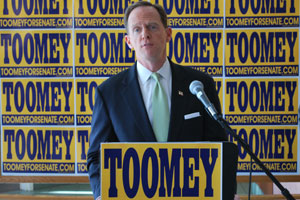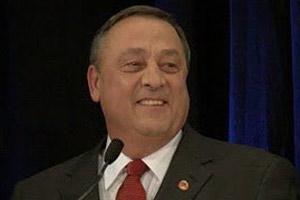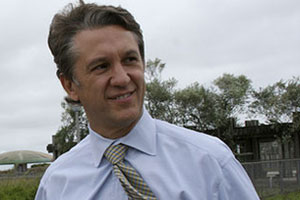
Pat Toomey. | <a href="http://www.toomeyforsenate.com/media/image-galleries/allentown-press-conference-1232009">Pat Toomey for Senate.</a>
You’ve probably heard a lot about wacky, radical candidates like Carl Paladino, Christine O’Donnell, Paul LePage, Sharron Angle, and Rand Paul. But lost in all the media finger-pointing is the fact that Pat Toomey, who in any other year would be among the most conservative candidates in the country, is on a glide path to take Arlen Specter’s old Senate seat. The former congressman and Wall Street banker has led in the Pennsylvania polls for months. And despite some apparent tightening in recent weeks, polling guru Nate Silver gives Toomey a 92 percent chance of beating his Democratic opponent, Rep. Joe Sestak.
In an attempt to close the gap, Dems have latched onto Toomey’s Wall Street past, hammering the Republican for opposing financial regulatory reform and supporting deregulation. Toomey’s an easy target for economic-centered attacks. As a Wall Street banker, Toomey helped pioneer the use of some of the same financial products that have caused fiscal chaos for American towns, cities, and states. He spent years as a derivatives trader for Chemical Bank and at Morgan Grenfell, a British financial firm. While at Morgan Grenfell, Toomey focused on things like interest rate swaps—complicated debt instruments that poisoned many a municipality’s portfolio. Shortly after he was elected to Congress in 1998, a trade magazine rejoiced that “now the derivatives industry can claim representation by one of its own.” Toomey parlayed his trading experience into a spot on the House banking committee, where he crusaded against regulation of financial markets—especially derivatives. And unless Sestak can stage an epic comeback, Toomey will soon be back in Congress, with a vote on banking regulation, if not a seat on the upper chamber’s powerful banking panel.
(Toomey’s campaign requested questions for this story via email, but did not respond to those questions or to follow-up requests.)
Here’s a glimpse of Toomey’s background trading derivatives and pushing the market deregulation that some blame for playing a leading role in the financial meltdown. Until the mid-1980s, derivatives—financial products whose value is derived from the value of a different, underlying asset, like a house or a bushel of wheat—were only legally in force if one of the two parties owned or had promised to buy the underlying asset. In order for the government to enforce the deal, one party effectively had to be insuring something—”hedging” against economic risk. You could still trade derivatives if neither party owned the asset, but you couldn’t use the court system to adjudicate these purely speculative wagers. At the time, the vast majority of derivatives trading took place on exchanges like the Chicago Mercantile futures exchange. The exchanges functioned as private trading clubs—and they had various internal rules designed to ensure traders could pay off their bets.
That all changed in 1986, when the UK passed a law—the Financial Services Act—that essentially made all derivatives trades legally enforceable, even if neither party in the transaction owned the underlying asset. The US followed suit soon afterwards, issuing a steady stream of regulatory exemptions that made one type of derivative after another legally enforceable. Lynn Stout, a derivatives expert at UCLA Law School, says the UK law and “how much money they were making in the City [of London]…spurred Wall Street to push for similar legal changes in the States.” Some people—like Brooksley Born, who went on to head the Commodity Futures Trading Commission from 1996 until 1999—argued against the changes. They were ignored.
Suddenly, investors could gamble on almost anything—and instead of the rules-based exchanges to enforce the deals, the government would do it—no questions asked. It was as if world governments had suddenly agreed to enforce every handshake bet you make with a buddy. This was the change that would allow a few hedge funders, years later, to place multibillion dollar bets against the US housing market and know that their counterparties would have to pay up—or go broke trying. Derivatives trades naturally exploded—and Toomey was right in the middle of the boom. The market “became quite sophisticated,” Toomey told Derivatives Strategy magazine in 1999. He was “dealing in various currencies, all kinds of interest rate and currency-related derivatives—options, swaps, forwards and so on.” In the five years after the UK law went into effect, the size of the global derivatives market more than quintupled. In 1991, when Toomey left the derivatives business, the notional value of global derivatives contracts reached nearly $4.5 trillion, up from $865 billion in 1986.
In the years that Toomey ran sales and trading at Morgan Grenfell, the company brokered a number of interest rate swap deals with municipal governments (called “local councils”) in the United Kingdom. (Although Toomey was based in New York, he also managed the firm’s derivatives business in Tokyo and London.) In the UK, municipalities are generally funded by the central government. But under Margaret Thatcher, their funding had become sharply limited, and many were searching for alternative, off-the-books methods of funding their operations. Morgan Grenfell and other derivatives dealers stepped into the breach, brokering deals with and between various municipalities. Interest rate swaps—where the two parties in effect bet on whether interest rates are going to go up or down—were especially popular. Many of these deals were in effect loans—the councils would receive large sums up front and pay them back over time based on interest rate differences. Of course, if the interest rates went the wrong way, you could end up owing far more than you initially anticipated.
Soon, some of the councils ended up deep in the red—and the British House of Lords “solved” the problem by ruling that it was illegal for the local authorities to have entered into the swap deals in the first place. The decision triggered a wave of litigation—including a watershed suit involving Toomey’s firm. In that case, Morgan Grenfell v. Welwyn Hatfield District Council, the court ruled that even though interest rate swaps could be used for wagering, they should generally assumed to be “not gaming or wagering,” but instead “commercial or financial transactions to which the law will in the absence of some other consideration give full recognition and effect.” That was the final blow to the old concept of legal unenforceability, and it sent a signal to derivatives brokers that courts would step in to enforce their contracts if necessary. And that would make some people dealing in interest rate and currency swaps—like Toomey—very rich.
During the campaign, Toomey has referred to the products he worked with as “non-risky” “common derivatives,” different from the “toxic” mortgage-backed derivatives that some believe caused the financial crisis. “That’s not true,” says Michael Greenberger, a professor at the University of Maryland and former CFTC official. “It just so happens that the 2008 meltdown involved credit default swaps, but interest rate swaps and currency swaps can be as risky as anything else. These swaps are very, very risky.”
Toomey’s defense ignores the recent history of interest rate swaps, which led to fiscal problems for many American towns, cities, and states across the country in recent years. The US never had a House-of-Lords-type decision forbidding municipalities from making these sorts of deals. So just as Morgan Grenfell had in the ’80s, US banks pressed local governments to agree to swap deals to bring in extra revenue. And this time, many of the banks allegedly paid kickbacks on the deals. (The kickbacks are the subject of an ongoing federal investigation.) In Pennsylvania alone, 107 school districts reportedly entered into swap deals—”gambling with the public’s money,” according to the state’s auditor general. Some have since paid millions of dollars to Wall Street banks to get out from under the deals. Chicago, Denver, Kansas City, Missouri, Philadelphia, Massachusetts, New Jersey, New York, and Oregon all recently lost money on similar swap deals, according to the Wall Street Journal.
Problems stemming from the sorts of derivatives Toomey traded date back before the crisis, too. And they don’t just affect governments. In 1998, the Fed had to organize a $3.6 billion bailout of Long Term Capital Management, a highly-leveraged hedge fund whose collapse threatened the stability of the global financial system. LTCM had gotten in trouble trading the same products that Toomey made his money working with—currency and interest rate swaps. LTCM wasn’t the only example. The bankruptcies of Orange County, California, in 1994 and the British bank Baring’s in 1995 (an event dramatized in the 1999 Ewan McGregor film Rogue Trader) were also driven by failed derivatives deals. Later, Larry Summers, who went on to become Obama’s top economic adviser, reportedly lost $1 billion on interest rate swaps as president of Harvard University.
None of the early derivative disasters seemed to have an impact on Toomey’s boosterism for the industry. When he came to Congress, he was on a mission. “The trend in deregulation, beginning in the early 1980s, is one of the biggest reasons for the sustained economic expansion,” he told Derivatives Strategy. “I would like to see us continue to deregulate on many fronts, including the financial services industry.” Toomey worked hard to make that happen. Sestak has attacked Toomey for helping to draft bipartisan legislation that repealed the Glass-Steagall act, allowing banks to combine their investment banking and commercial divisions—and to become the behemoths that later had to be bailed out by taxpayers. But economists differ over whether Glass-Steagall repeal exacerbated the economic crisis.
What economists do agree on is that the lack of regulation of derivatives—especially newly invented types of credit and equity swaps—was a major factor leading to the financial meltdown. The Glass-Steagall repeal bill also included a provision dealing with—or rather failing to deal with—derivatives regulation. Most members of Congress who voted for the bill focused on the Glass-Steagall bit. But Toomey—whom the derivatives industry saw as “one of its own“—zeroed in on the derivatives element. “I’m particularly pleased this bill contains an important provision regarding…credit and equity swaps,” Toomey said in a November 1999 speech on the House floor. He went on to say that swaps were already “adequately regulated” and would “continue” to be regulated by banking supervisors, state-level officials with little power over national financial markets.
There was a lot of financial deregulation in 1999 and 2000, and Glass-Steagall repeal was just a part of it. In December 2000, Sen. Phil Gramm (R-Texas), a right-wing economist who went on to become John McCain’s economic adviser (he’s the one who said America was a “nation of whiners“), inserted an 262-page law called the Commodity Futures Modernization Act (CFMA) into an unrelated bill. (Read more about “Foreclosure Phil.”)
The CFMA basically ensured the full deregulation of derivatives—completing the process that had begun in the UK in 1986. It was introduced on a Friday night two days after the Supreme Court’s Bush v. Gore decision and right before the Christmas recess. For better or worse (well, for worse), most members of Congress didn’t even read the CFMA or know what it did. It passed overwhelmingly because few people understood it, and it was attached to a 11,000-page, must-pass, pork-stuffed appropriations bill that was going to pass anyway. (Wendy Gramm, Phil Gramm’s wife, had been a key player in the partial derivatives deregulation from 1988 to 1993, when she was at the CFTC.)
Unlike most members of Congress, Toomey, the former derivatives trader, knew exactly what was going on with the CFMA—and had been pushing for it for months. In October, he had urged Congress to pass a similar bill—saying that it would “eliminate most of the cloud of legal and regulatory uncertainty that has shadowed” derivatives since their invention. Two months before that, he boasted to a House banking committee hearing that the derivatives industry “has done enormous good and has been an enormous force for positive change in our economy generally.”
Toomey’s derivatives cheerleading continued for the duration of his time in Congress. In 2001, he boasted on a campaign website that he had been “putting his experience in International finance to work” on “important legislation,” including the “authorization of derivatives trading.” In 2003, he praised the expansion of the derivatives market as “perhaps the most important, creative and innovative development in finance in the last 30 years.”
By the time of the 2008 crash, derivative swaps had grown into a market with a notional worldwide value of $600 trillion—ten times the annual output of every economy in the world. The state banking supervisors who Toomey said would “continue to regulate” swaps did nothing while traders at Merrill Lynch, Lehman Brothers, Bear Stearns, and AIG made bets they couldn’t possibly pay out on. Eventually, the system collapsed on itself.
Toomey didn’t see it coming. In fact, he has a history of playing down the threat of systemic financial problems. The planners of the 1998 LTCM hedge fund bailout were hailed on the cover of Time magazine as the “Committee to Save the World.” But for Toomey, the lesson of the committee’s work was not that the financial system was fragile or that highly leveraged financial institutions could bring others down with them. Nor was it that unregulated, off-exchange derivatives trading could lead to disaster. Instead, he promised Derivatives Strategy readers that he would “resist…any effort to impose inappropriate regulations.” After all, he said, LTCM was a “big problem” that was “essentially solved.” Not everyone agrees. “I have found virtually no evidence that the legalization of speculative derivatives did anything other than increase systemic risk,” Stout says.
In some sense, Toomey’s triumphalist attitude towards derivatives is unsurprising. It’s not just because his ideological conservatism predisposes him to loathe regulation. It’s also because unregulated trading of derivatives benefited him and his family. As Upton Sinclair said, “It is difficult to get a man to understand something, when his salary depends upon his not understanding it!” But perhaps a quote from Derivatives Strategy is more appropriate. After hearing Toomey’s positions on regulation, the trade paper rejoiced. Toomey’s “passionate discourse is music to the ears of derivatives players around the country,” the paper reported. And indeed it was. Unfortunately, things didn’t work out too well for the rest of us.














